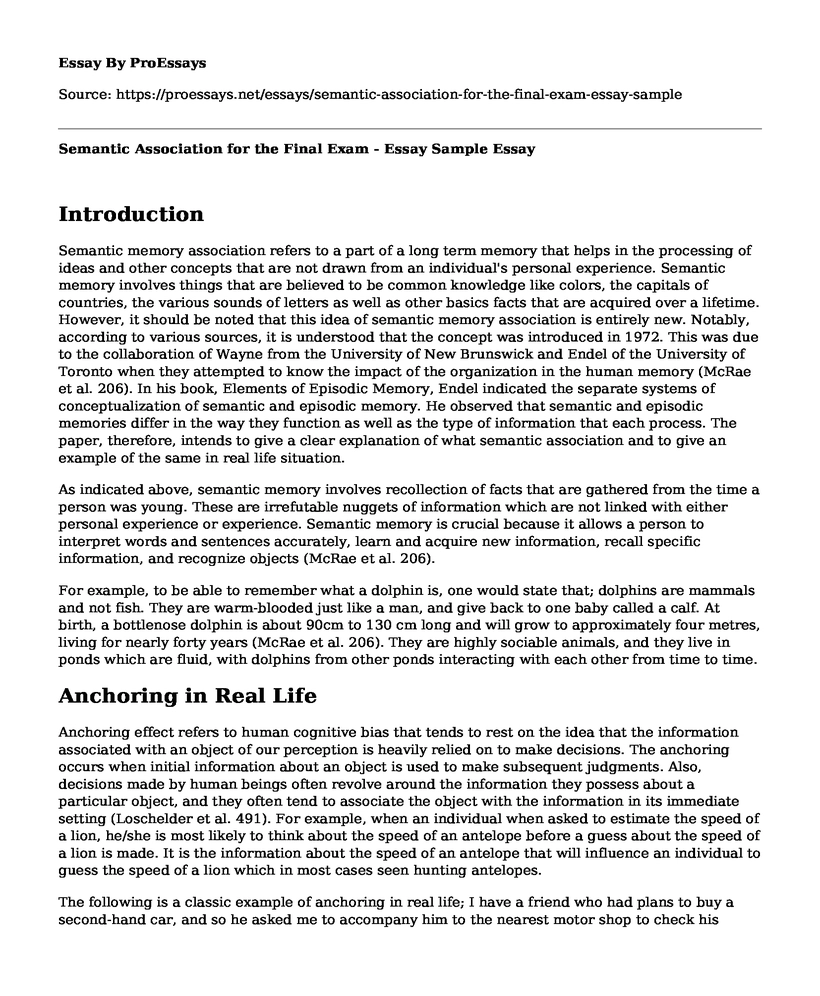Introduction
Semantic memory association refers to a part of a long term memory that helps in the processing of ideas and other concepts that are not drawn from an individual's personal experience. Semantic memory involves things that are believed to be common knowledge like colors, the capitals of countries, the various sounds of letters as well as other basics facts that are acquired over a lifetime. However, it should be noted that this idea of semantic memory association is entirely new. Notably, according to various sources, it is understood that the concept was introduced in 1972. This was due to the collaboration of Wayne from the University of New Brunswick and Endel of the University of Toronto when they attempted to know the impact of the organization in the human memory (McRae et al. 206). In his book, Elements of Episodic Memory, Endel indicated the separate systems of conceptualization of semantic and episodic memory. He observed that semantic and episodic memories differ in the way they function as well as the type of information that each process. The paper, therefore, intends to give a clear explanation of what semantic association and to give an example of the same in real life situation.
As indicated above, semantic memory involves recollection of facts that are gathered from the time a person was young. These are irrefutable nuggets of information which are not linked with either personal experience or experience. Semantic memory is crucial because it allows a person to interpret words and sentences accurately, learn and acquire new information, recall specific information, and recognize objects (McRae et al. 206).
For example, to be able to remember what a dolphin is, one would state that; dolphins are mammals and not fish. They are warm-blooded just like a man, and give back to one baby called a calf. At birth, a bottlenose dolphin is about 90cm to 130 cm long and will grow to approximately four metres, living for nearly forty years (McRae et al. 206). They are highly sociable animals, and they live in ponds which are fluid, with dolphins from other ponds interacting with each other from time to time.
Anchoring in Real Life
Anchoring effect refers to human cognitive bias that tends to rest on the idea that the information associated with an object of our perception is heavily relied on to make decisions. The anchoring occurs when initial information about an object is used to make subsequent judgments. Also, decisions made by human beings often revolve around the information they possess about a particular object, and they often tend to associate the object with the information in its immediate setting (Loschelder et al. 491). For example, when an individual when asked to estimate the speed of a lion, he/she is most likely to think about the speed of an antelope before a guess about the speed of a lion is made. It is the information about the speed of an antelope that will influence an individual to guess the speed of a lion which in most cases seen hunting antelopes.
The following is a classic example of anchoring in real life; I have a friend who had plans to buy a second-hand car, and so he asked me to accompany him to the nearest motor shop to check his favorite model from the yard. In assessing the prices attached to various models of his liking, he realized that they were costly. The price of a new Mercedes E200 was $4000, new Mercedes E250 was $5000, and the old model of the same Mercedes was $2000. The price of the model he wanted to buy in the adjacent shop was retailing at $1200 though he was under the illusion that the model he wanted is cheaper in the first shop. Now, this misjudgment comes as a result of the information of the immediate surrounding he has access to (Loschelder et al. 494). He is deciding on buying the relatively expensive model because the surrounding prices of the new models Mercedes are higher than the one he wants to buy. From the above example, there is absolute anchoring. To avoid this, he could decide between walking around to check the different prices of the model he wanted to buy in at least two other shops so that he can come up with an evaluation of the price attached to the model in the first shop which was $1200.
In respect to the above illustration, it is worth to note that, biases on the part of the human during the interpretation of the initial information about a particular object may sometimes be used to adjust other anchors away from the initial object.
Works Cited
Loschelder, David D., Johannes Stuppi, and Roman Trotschel. ""EUR 14,875? Precision boosts the anchoring potency of first offers." Social Psychological and Personality Science 5.4 (2014): 491-499.
McRae, Ken, and Michael Jones. "14 Semantic Memory." The Oxford handbook of cognitive psychology 206 (2013).
Cite this page
Semantic Association for the Final Exam - Essay Sample. (2022, Dec 16). Retrieved from https://proessays.net/essays/semantic-association-for-the-final-exam-essay-sample
If you are the original author of this essay and no longer wish to have it published on the ProEssays website, please click below to request its removal:
- Research Paper on Children and Technology
- Tom and Jerry in Childhood Essay Example
- Breastfeeding, Family Socioeconomic, Parenting Behaviors: Impact on Academic Achievement
- Argumentative Essay: Should Children Be Taught Sex Education in Schools?
- Essay Example on Changes in NYS English Learning for ELL Students: 4 Ways to Identify, Support, Help
- Paper Example on Identifying Exceptionalities of Exceptional Students: ESE/94-142/IDEA
- Research Paper Example on Innovate & Entrepreneur: The Keys To Success In A Competitive Market







